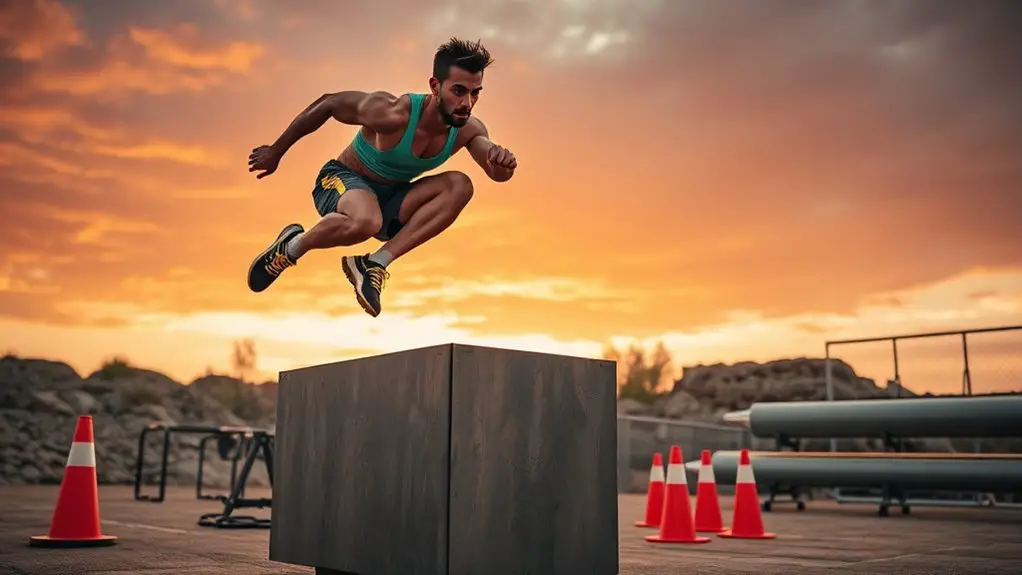To train like an MMA fighter, you should focus on a mix of strength and conditioning. Incorporate compound movements, like squats and deadlifts, for power. Add in high-intensity interval training and cardio workouts for endurance. Master striking and grappling techniques while sparring to apply your skills. Don't forget to develop mental toughness and fuel your body with nutritious foods. To truly enhance your training, there's more you can explore about recovery and mindset.
Building a Strong Foundation: Essential Conditioning Exercises
When you're training like an MMA fighter, building a strong foundation with essential conditioning exercises is crucial for success. You can't just rely on technique; your body needs to be ready for the intensity of combat. Start with strength training—compound movements like squats, deadlifts, and bench presses will build your overall power. Don't forget about cardiovascular conditioning; running, cycling, or rowing will enhance your endurance and keep you agile in the ring.
Incorporate high-intensity interval training (HIIT) to improve your speed and explosiveness. Exercises like burpees and kettlebell swings can really push your limits. Flexibility is key too; make sure to include dynamic stretches and mobility work to prevent injury and maintain fluid motion. Finally, listen to your body. Recovery is just as important as training, so make sure you're giving yourself time to rest and recharge. This foundation will empower you to release your true potential. Additionally, incorporating full-body strength exercises into your routine can further enhance your functional strength and stability.
Mastering the Techniques: Skill Development for MMA
Building a solid foundation is just the beginning; mastering the techniques is where you'll truly refine your MMA skills. Focus on the core disciplines: striking, grappling, and submissions. Get comfortable with punches, kicks, and elbow strikes; they're your tools for freedom in the cage. Practice your footwork and head movement to become elusive and unpredictable.
Next, immerse yourself in grappling techniques. Whether it's Brazilian Jiu-Jitsu or wrestling, learn to control your opponent and escape submissions. The more you practice, the more instinctive these moves will become.
Lastly, don't forget about sparring. It's essential for applying what you've learned in real-time. Be open to feedback; every session is a chance to grow. Embrace the struggle and celebrate each small victory along the way. With dedication and practice, you'll develop the skill set needed to thrive in the MMA world and enjoy the freedom that comes with it. Additionally, incorporating high-intensity interval training into your regimen can significantly enhance your performance and endurance.
Crafting a Balanced Training Regimen: Combining Strength and Cardio
While you might be enthusiastic to jump into the technical aspects of MMA, crafting a balanced training regimen that combines strength and cardio is essential for overall performance. You need to guarantee your body can withstand the demands of fighting while maintaining agility and speed.
Start by integrating strength training sessions, focusing on compound movements like squats, deadlifts, and bench presses. These exercises build functional muscle, giving you the explosive power needed during fights. Aim for two to three strength sessions per week. Additionally, incorporating squats and deadlifts into your regimen can significantly enhance your overall strength and stability.
Integrate strength training with compound movements to build explosive power for MMA fights. Aim for two to three sessions weekly.
On the other hand, don't neglect cardio. Incorporate high-intensity interval training (HIIT) and steady-state cardio to enhance your endurance and recovery. Activities like running, cycling, or swimming can keep your heart healthy and improve your stamina.
Ultimately, mixing strength and cardio not only prepares your body for the rigors of MMA but also fuels your passion for freedom in the cage.
The Importance of Mental Toughness: Developing a Fighter's Mindset
Mental toughness is the cornerstone of success in MMA, shaping not just your performance in the cage but also your approach to training and life. It's about pushing through the pain, overcoming self-doubt, and embracing challenges. When you step into the gym, remind yourself that every struggle is an opportunity to grow stronger.
Developing a fighter's mindset means cultivating resilience and focus. You'll face setbacks and tough days, but it's how you respond that defines you. Embrace the grind; it's where real freedom lies. Understanding mental toughness is essential for separating great athletes from others.
Visualize your goals and stay committed, even when motivation wanes. Surround yourself with supportive, like-minded individuals who inspire you to push further. Remember, mental toughness isn't just about physical strength; it's about believing in yourself and your journey.
Nutrition and Recovery: Fueling Your Body for Peak Performance
To achieve peak performance in MMA, you need to prioritize nutrition and recovery as vital components of your training regimen. Your body's a high-performance machine, and the fuel you put in matters. Focus on whole foods—lean proteins, healthy fats, and plenty of fruits and veggies. These'll give you the energy to push through intense workouts and recover afterward.
Hydration's just as important. Drink water consistently, and consider electrolyte-rich drinks during long sessions to keep your body balanced. Proper hydration is essential for optimal performance and helps avoid fatigue and cramps. Recovery isn't just about rest; it's about sleep quality, too. Aim for 7-9 hours each night to let your muscles repair and grow.
Don't overlook active recovery days—light workouts can enhance blood flow and help lessen soreness. Listen to your body; if you're feeling drained, take a break. Fueling and recovering right is your ticket to releasing your full potential in the cage.
Frequently Asked Questions
What Gear Do I Need for MMA Training?
To get started, you'll need gloves, shin guards, and a mouthguard. You'll also want comfortable training clothes, hand wraps, and a durable gym bag. These essentials will help you train hard and stay safe while enjoying your journey.
How Often Should I Train Each Week?
You should aim to train at least three to five times a week. Consistency's key, but listen to your body. Finding that balance between pushing yourself and allowing recovery's what'll truly set you free.
Can I Train MMA if I'm Not Competing?
Absolutely, you can train MMA even if you're not competing. It's a fantastic way to improve fitness, learn self-defense, and build confidence. Just focus on your goals, enjoy the journey, and embrace the freedom it offers!
What Are Common Injuries in MMA Training?
While training, you might sprain your ankle, like a friend who pushed too hard during sparring. Common injuries include cuts, strains, and concussions. Staying mindful and listening to your body can help prevent these issues.
How Do I Find a Good MMA Gym?
To find a good MMA gym, start by researching local options, reading reviews, and visiting facilities. Observe classes, meet trainers, and check for a positive atmosphere that encourages learning and personal growth.




